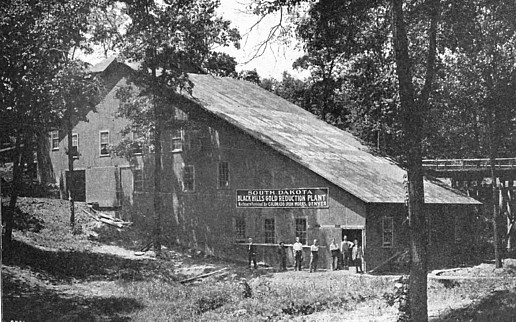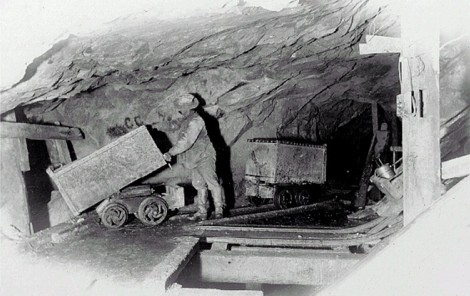Before opening a metal mine it is well to consider the following points. The nature and quantity of the material to be extracted; the general form of the deposit ; the depth at which you may have to work ; the nature of the boundaries (roof, floor, walls] the thickness of the deposit ; its hardness and physical structure; the existence or nonexistence of faults; the quantity of water which may be met with in the ground. To work economically, if possible arrange the works so that 'the underground transport shall be short, the slopes clear of water, and so that there shall be good ventilation, and the men not crowded. In ordinary lodes, half or three quarters of the men employed underground may be engaged in exploratory work (dead or head work.)
Working- Lodes of
Ordinary Width.
Ordinary lodes which are from 2 feet to 6 feet wide, are worked either
by overhand or underhand sloping. In Cornwall the price of stoping varies in
cost depending on the width of the vein.
Overhand Stoping
It is better to commence from a winze than by breaking in. Tools and
materials can be easily lowered down a winze, and the winze also acts as a
passage for air. A fair height for a stope is 6 or 7 feet. A high face
allows the material to come down in blocks, but the stage necessary for the
workmen in such a case has to be removed before firing a shot. The length of
a face may be from 20 to 40 feet. When the slopes are small the men may be
inconveniently near to each other when a shot is fired. The workmen advance
quickly if the joints in the rock dip towards them. A pass is formed by the
walls, stemples and attle, or it may be timbered like a winze. The bottom of
the pass ought to be larger than the top to prevent jamming. In a 90 feet
pass the top may be 3 feet square and the bottom 4 feet 6 inches square. The
limiting inclination is about 50. The advantages of overhand stoping are, I.
The ground breaks readily. 2. The ore is thrown down a pass. 3. The water
drains away. 4. The ventilation is good. 5. There is less timber employed as
compared with underhand sloping, unless there are not enough dead ended
workings to fill in with. The disadvantages are. I. The dead work of driving
a level beneath the deposit. 2. The danger to the workmen. 3. The loss of
ore amongst the attle. 4. The inconvenient position in which the men work.
Underhand Stoping
The floor and face of a stope ought to dip downwards. The height of the
face may be 6 or 10 feet and the floor 25 to 40 feet. The advantages of this
method are, I. The work may be commenced without previous dead work. 2.
There is little risk of accident. 3. The workmen may use heavy double handed
tools. 4. There is little loss of ore. The disadvantages are, I. The passing
up of the ore. 2. The risk of water accumulating. 3. The quantity of timber
required. 4. The difficulty of ventilation. These latter objections hardly
apply if the usual system is followed of putting down a winze and
bottom-stopping into it. Narrow widths- in working narrow veins a strip of
the wall may be first removed and then the vein broken down unmixed with
wall rock (stripping) otherwise they are worked by the ordinary methods of
sloping.
Working Wide Lodes
Wide lodes are lodes where the material of the lode is too weak to stand
as a roof without support.' Generally any lode over 8 or 10 feet will fall
within this category. I. By Horizontal Slices. A level is driven along the
footwall and at intervals of say 18 feet, levels or cross cuts are driven
across the lode to the hanging wall. By driving these levels, a certain
quantity of material is obtained from the lode. The cross cuts are then
packed with attle, and a second set of new cross cuts are started inside the
pillars: These being packed, a third set of cross cuts (each cross cut being
6 feet in width j will complete the extraction of a horizontal slice taken
out transversely or across the lode from the footwall to the hanging wall. A
second slice is then taken out at a higher level and so the work proceeds
slice by slice working upwards. If it is not desirable to come in contact
with the stowing, a thin slice of the vein may be left as a floor between
two successive slices. When taking out slices in a descending order, the
works in the upper slice should be in advance of those below. 2. By Vertical
Slices. At Almaden in Spain, slices are taken vertically from level to
level, the walls being supported by masonry. 3. Working by Pillars. This
method is adopted where stowage is difficult to obtain. The slices, which
are much thicker than in the previous method, are removed in descending
order. Cross-cuts are driven from a main level in the hanging wall side, and
possibly also another set of levels at right angles, so that a slice is
divided up into a number of pillars. The pillars and portion of the roof are
then cut away until the roof commences to fall, these operations commencing
in the part of the mine furthest removed from the shaft. After this a second
slice is commenced at a lower level, leaving a sufficiently strong roof
between it and the crushed-in workings above. When working several slices
simultaneously, the stripping of pillars, in a lower level must not be
commenced until the upper level has been completely worked.
Examples of the cross-cut method with pillars are found at the Stahlberg Iron Mines, the calamine workings in Silesia, the alum shales at Liege etc. If the deposit is large, drive round it a horizontal contour level. This may be used as a main level from which cross cuts may be driven and the deposit worked out by the method of horizontal slices. The pillar method may also be employed. When material is extracted by a series of chambers the pillars of a lower tier are made larger than those of a tier at a higher level. At Musen near Siegen the vaults are i8ft. high and the pillars between are 1 2ft. thick. Only one-third of the material (iron carbonate) is obtained from each level.
Post and Stull Method.
Usually a shaft is sunk on the deepest side (dip side) of the area to be
worked, in a central position on that side. Two or more levels (say 10 feet
wide) are driven parallel to the strike (dip head level, lodgment level or
water way) slightly inclined towards the shaft. The lower of these is used
to convey water to the sump, while the others are employed for haulage or as
a level from which the stulls or boards are laid out when working (winning)
the coal. These are usually laid out, so that they advance in a direction at
right angles to the cleat or cleavage, such a direction being known as " on
the face or board ways" The direction at right .angles to this is known as "
on the ends." Occasionally circumstances (as for example a steep dip) demand
that the boards shall advance obliquely to the cleat or even parallel to it,
that is on the ends. When there is only one direction of cleat, the coal has
a tendency to break into prismatic forms. If there are two sets of cleavage
at right angles (backs and cutters) the coal will be cuboidal if oblique,
rhomboidal &c If advancing at right angles to well defined backs, the coal
will come away with ease, but in consequence of the under-Cutting and
falling, so many additional fissures may be produced, that two much stnaffs
or dust coal may be produced. In such a case, advance the boards in some
direction oblique to the backs or even on end.
The winning headway from which boards are driven may therefore be parallel to the strike, the dip, or in some intermediate direction. At least two board ways which are as wide as the roof will stand without support (10 to 15 feet) are driven together. After advancing a certain distance the working faces are joined by a passage or thirling, parallel to the winning headway. The boards are then advanced, a second thirling driven and the first thirling may be temporarily stopped. The ventilating current now passes round the working faces through the second thirling. By a system of boards and thirlings at right angles to each other the area to be worked, is cut up into a series of pillars. If these pillars are made too small they become crushed and cannot be subsequently removed, and more than half of the whole seam may be destroyed.
Continue on to:
Quartz Lode Mining Systems, Part II, Shafts
Return To:
Hard Rock Quartz Mining and Milling


